Walton, James (Flying Officer)
Killed in Flying Accident 1959-April-28
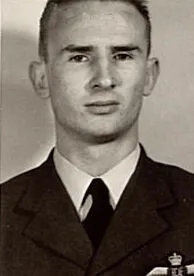

Birth Date: 1937
Born: Calgary, Alberta
Parents: Son of James and Anne Walton. Brother of Lorraine Mason and Dianne Bosma.
Spouse:
Home: Calgary, Alberta
Enlistment:
Enlistment Date: unkown date
Service
RCAF
Unit
440 Sqn- Squadron
Ka Ganawaitak Saguenay He who protects the Saguenay: innu
Base
Rank
Flying Officer
Position
Pilot
Service Numbers
104550
Home
 Calgary, Alberta
Calgary, Alberta
Crew or Other Personnel
Silver Star 21586
Silver Star serial: 21586
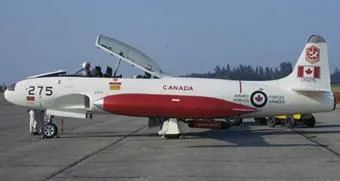
The Canadair CT-133 Silver Star (company model number CL-30) is the Canadian license-built version of the Lockheed T-33 jet trainer aircraft, in service from the 1950s to 2005.
The Canadair CT-133 was the result of a 1951 contract to build T-33 Shooting Star trainers for the Royal Canadian Air Force (RCAF). The powerplant is a Rolls-Royce Nene 10 turbojet instead of the Allison J33 used by Lockheed in the production of the original T-33. A project designation of CL-30 was given by Canadair and the name was changed to Silver Star. The appearance of the CT-133 is very distinctive due to the large fuel tanks usually carried on each wingtip. A total of 656 CT-133 aircraft were built by Canadair.
The CT-133 entered service in the RCAF as its primary training aircraft for fighter/interceptors. The designation of the Silver Star in the Canadian Forces was CT-133.
The CT-133's service life in the RCAF (and later the Canadian Forces) was extremely long. One of the more unusual roles it played was as an aerobatic demonstration aircraft, the RCAF's Red Knight. Although the aircraft stopped being used as a trainer in 1976, there were still over 50 aircraft in Canadian Forces inventory in 1995. The youngest of these airframes was then 37 years old and had exceeded its expected life by a factor of 2.5. During this period, the Canadair T-33 was employed in communication, target towing, and enemy simulation. Wikipedia
Unit Desciption
440 Sqn Ka Ganawaitak Saguenay ("City of Ottawa")
History of the Squadron before and during World War II (Aircraft: Hurricane IV, Typhoon IB)

[ Note that during WWII the squadron did not have a badge nor a motto. These were awarded later.]
The squadron was formed in Vancouver on 5 October 1932 as No. 11 (Army Co-Operation) Squadron' before being redesignated No. 111 (Coast Artillery Co-Operation) Squadron on 15 November 1937. At the outbreak of the Second World War the squadron formed a detachment at Patricia Bay  on Vancouver Island, before being redesignated No. 111 (Fighter) Squadron on 1 July 1940. It was disbanded on 1 February 1941 and then reformed on 3 November 1941. The squadron took part in air defence operations in Western Canada and the Aleutian Islands Campaign under Western Air Command.
No 440 (F) Squadron was formed in Rockcliffe, Ontario
on Vancouver Island, before being redesignated No. 111 (Fighter) Squadron on 1 July 1940. It was disbanded on 1 February 1941 and then reformed on 3 November 1941. The squadron took part in air defence operations in Western Canada and the Aleutian Islands Campaign under Western Air Command.
No 440 (F) Squadron was formed in Rockcliffe, Ontario  as No. 111 (F) Squadron RCAF. .It was the third of six home squadrons transferred overseas without its aircraft, and was re-designated No. 440 (FB) Squadron RCAF at Ayr, Scotland
as No. 111 (F) Squadron RCAF. .It was the third of six home squadrons transferred overseas without its aircraft, and was re-designated No. 440 (FB) Squadron RCAF at Ayr, Scotland  on February 8, 1944. It flew Typhoon aircraft in the preparation for D-Day and afterwards gave close support to the ground troops by dive-bombing and strafing enemy strongpoints, bridges, and road and rail traffic. They moved with the ground troops through France, the Low Countries, and Germany. The squadron was disbanded at Flensburg, Germany
on February 8, 1944. It flew Typhoon aircraft in the preparation for D-Day and afterwards gave close support to the ground troops by dive-bombing and strafing enemy strongpoints, bridges, and road and rail traffic. They moved with the ground troops through France, the Low Countries, and Germany. The squadron was disbanded at Flensburg, Germany  on August 26, 1945.
on August 26, 1945.
In the course of operations, the squadron flew 4213 sorties for the loss of 38 aircraft and 32 pilots, of whom 23 were killed, 5 missing, and 3 POWs. They dropped 2215 tons of bombs and accounted for a large number of rail and road vehicles. The squadron amassed 5 DFCs. Battle Honours were: Fortress Europe 1944, France and Germany 1944-45, Normandy 1944, Arnhem, Rhine, Aleutians 1942-43. Wikipedia, Kostenuk and Griffin
Maps for Movements of 440 Squadron 1944-45
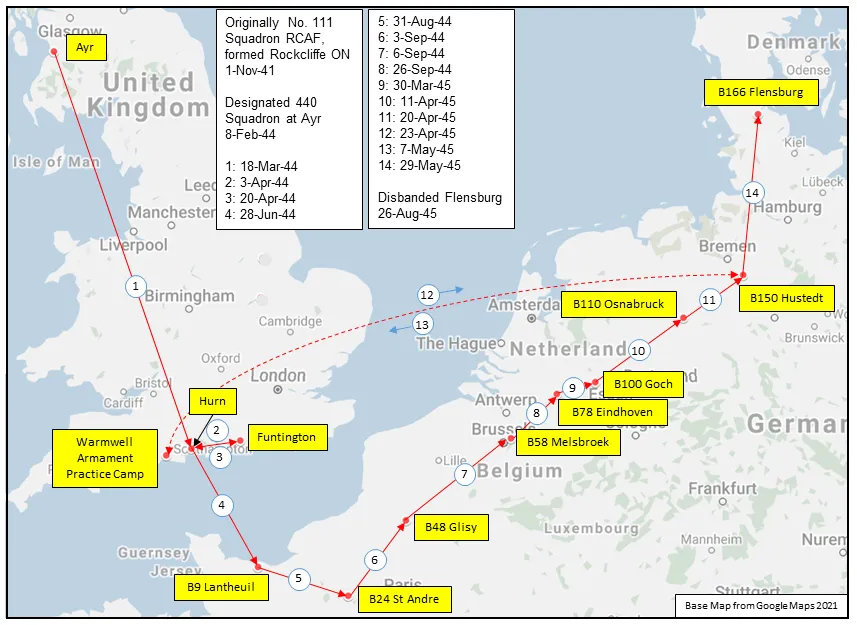
MAP 1: 440 Squadron Movements 1944-45 (right-click on image to display enlarged in new tab)
|
440 Squadron History Summary 1944-45
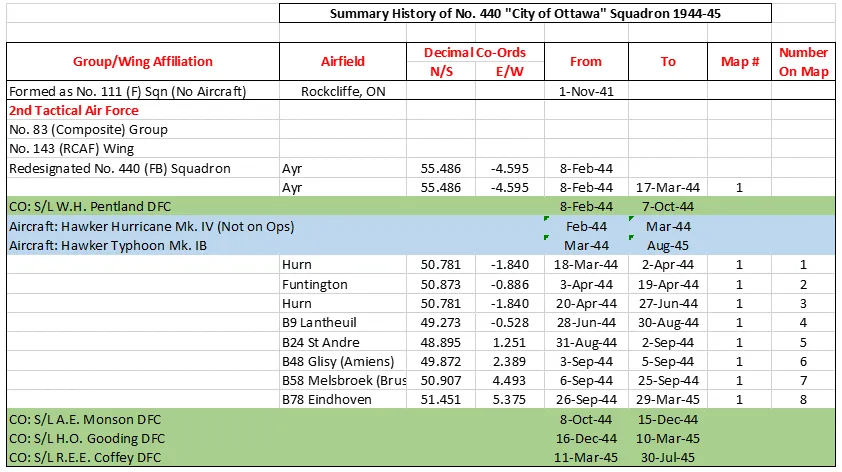
440 Squadron History Summary 1944-45 Page 2

History of the Squadron Post-WWII (Aircraft: Canuck 3B, 4B, Buffalo, Twin Otter)
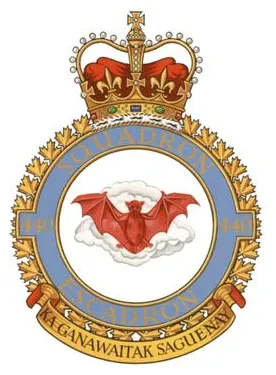
The squadron was re-formed as '440 All Weather (Fighter) Squadron' at Bagotville, Quebec  1 October 1953, flying Avro CF-100 Canuck all-weather fighters. In May 1957 it joined No. 1 Air Division Europe to replace No. 413 (F) Squadron at Zweibrucken, Germany
1 October 1953, flying Avro CF-100 Canuck all-weather fighters. In May 1957 it joined No. 1 Air Division Europe to replace No. 413 (F) Squadron at Zweibrucken, Germany  . When the CF-100 was withdrawn from service, the squadron was disbanded on 31 December 1962.
. When the CF-100 was withdrawn from service, the squadron was disbanded on 31 December 1962.
The squadron was reactivated a final time 8 July 1968 at CFB Winnipeg, Manitoba  as No. 440 Communications and Rescue Squadron with Douglas Dakotas and Vertol H-21 helicopters and redesignated as 440 Transport and Rescue Squadron in October. They later moved to CFB Namao, Alberta
as No. 440 Communications and Rescue Squadron with Douglas Dakotas and Vertol H-21 helicopters and redesignated as 440 Transport and Rescue Squadron in October. They later moved to CFB Namao, Alberta  , just outside Edmonton where they operated de Havilland Canada CC-115 Buffalo and CC-138 Twin Otters. At the time, two of the Twin Otters were stationed in Yellowknife, NWT
, just outside Edmonton where they operated de Havilland Canada CC-115 Buffalo and CC-138 Twin Otters. At the time, two of the Twin Otters were stationed in Yellowknife, NWT  , and in 1994 after CFB Namao closed the squadron moved north to be redesignated No. 440 Transport Squadron in 1995.
, and in 1994 after CFB Namao closed the squadron moved north to be redesignated No. 440 Transport Squadron in 1995.
The Squadron's tasks include airlift, utility and liaison flights in support of Canadian Armed Forces in the north, including support to the Canadian Rangers. Like all Royal Canadian Air Force flying squadrons, 440 Squadron can conduct search and rescue missions when requested by Joint Rescue Coordination Centres. They also conduct free fall live parachute operations, cargo delivery to troops in the field, and fishery patrols on Great Slave Lake. 440 Squadron operates four of the famous Canadian-designed and produced CC-138 Twin Otters to carry out its wide range of tasks. The Squadron operates these rugged aircraft in some of the harshest weather conditions on the planet and is the only formed RCAF unit that is based full-time in the north. The Squadron is comprised of approximately 55 members who are a mixture of Regular Force and Reserve Force members. In addition to conventional airport operations, the Squadron maintains the capability to conduct "off-airport" operations on skis in the winter and on tundra tires in the summer.
 Canadian Virtual War Memorial
Canadian Virtual War Memorial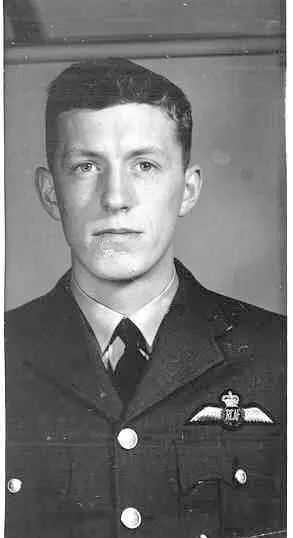

 Wikipedia Canadair CT-133 Silver Star
Wikipedia Canadair CT-133 Silver Star Harold A Skaarup Web Page
Harold A Skaarup Web Page